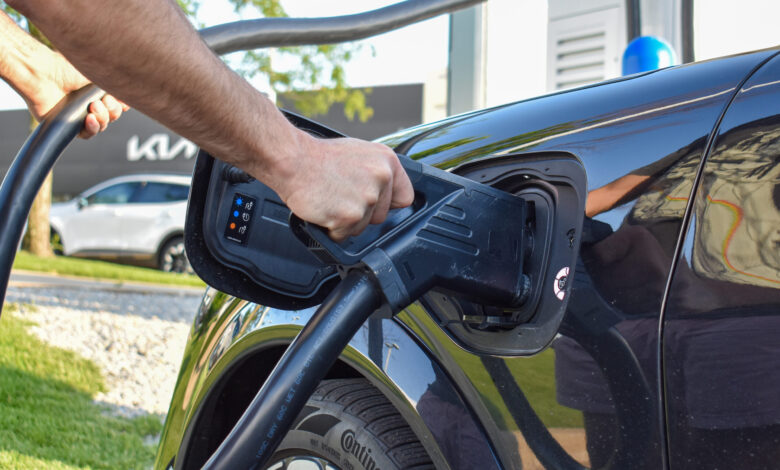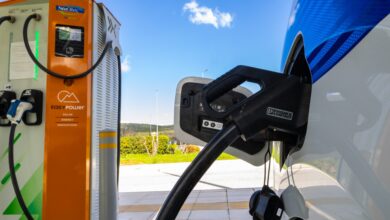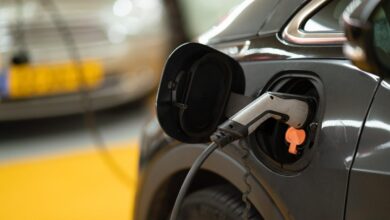EV charging infrastructure growing slowly in Iowa

A devoted environmentalist, Mike Carberry purchased a Chevy Bolt last year and is now among the relatively small number of Iowans driving a fully electric vehicle. It’s a new experience for the Iowa City man. “You have to kind of change your lifestyle a bit,” he says. Finding an electric vehicle (EV) charging station isn’t […]
A devoted environmentalist, Mike Carberry purchased a Chevy Bolt last year and is now among the relatively small number of Iowans driving a fully electric vehicle.
It’s a new experience for the Iowa City man.
“You have to kind of change your lifestyle a bit,” he says. Finding an electric vehicle (EV) charging station isn’t as easy as just pulling into one of the many gasoline stations that are sprinkled throughout practically every corner of the state.
According to the federal government, there are 371 public charging stations, with 857 ports, across Iowa as of mid-May. And while the number of stations is growing — there were just 348 locations in January — they’re mostly in the more populated areas.
The Biden administration is trying to raise those numbers. The Bipartisan Infrastructure law, passed and signed by President Joe Biden in 2021, devoted $7.5 billion over five years to help add charging stations, with a goal of getting to 500,000 by 2030.
Of that total, $5 billion has gone to the states, and Iowa just passed a major milepost on its way to adding more locations here.
In mid-April, the window for accepting applications closed for the first tranche of money to build charging stations on four major interstates across Iowa. The response went “very well,” according to Garrett Pedersen, director of the systems planning bureau at the Iowa Department of Transportation (IDOT). The state received 80 applications, and now those proposals are undergoing study to see whether they meet the specifications to qualify for the federal funding.
Then, they’ll be evaluated and scored.
The state of Iowa was allocated about $51 million, and it anticipates awarding between $20 million and $30 million in this first round of funding.
Awards are expected to be announced in late summer.
“We’ve been planning a four-month evaluation process,” Mr. Pedersen said.
Construction probably wouldn’t occur until next year.
The law requires that the funding go to charging stations with a minimum of four 150-kilowatt ports and be spaced no more than 50 miles apart on one of the federally designated Alternative Fuel Corridors. In Iowa, those corridors are Interstates 80, 380, 35 and 29.
Currently, there are only four to six existing stations that meet the federal criteria. Additional criteria also must be met to qualify.
The state has not identified any of the applications specifically, but there are proposals for all of the corridors.
Interstate 80, being the longest corridor, naturally had the most applications.
“But I would say in terms of coverage we were very pleased with what we got for coverage of each of those routes,” Mr. Pedersen said, adding the caveat that the applications still must be vetted for responsiveness.
Many of the applications were located at or near existing filling stations, convenience stores and hotels.
Charging infrastructure needed statewide
The state’s Electric Vehicle Infrastructure Deployment Plan, which was updated last year, has identified 16 priority zones along these alternate fuel corridors, including two on I-380 and two others on I-80 between Iowa City and Davenport.
Once the state meets the federal criteria for building charging stations — and they are “built out” — it then can look to other parts of the state with whatever amount of federal money is left over. Two, and possibly three, rounds of funding are anticipated.
Mr. Carberry, the new EV owner, says charging infrastructure is definitely needed off Iowa’s interstates and the state needs to make greater investments in the system. Mr. Carberry puts a lot of miles on his car, and when his business takes him to some of Iowa’s smaller communities, the lack of a robust charging infrastructure is evident.
For example, he was in Independence, Iowa, recently. “There’s probably not a public charger anywhere in the county,” he told the QCBJ.
A lack of charging stations is a major reason that people have hesitated to buy electric vehicles. Long recharge times, purchase costs and range anxiety are among the other barriers, according to Iowa’s EV infrastructure plan.
Still, electric vehicle purchases — while a small part of the overall vehicle registrations in the state — are growing quickly. In July of last year, there were 12,805 registrations, including hybrids, according to IDOT data. At the end of the year, that number had jumped to 15,159, an 18% increase.
Increases in Linn, Johnson and Scott counties are similar.
Charging stations also are growing in number, but not as fast as vehicle registrations.
Between the end of 2022 and 2023, the number of charging stations in Iowa grew about 20%, or roughly half the rate of registrations, according to data from the U.S. Department of Energy.
Local governments eye EV charging stations
In Eastern Iowa, several local governments and planning organizations banded together to form an electric vehicle readiness plan a few years ago. Among the goals was to increase the charging infrastructure in their area.
In Iowa City, the plan said there were 29 public charging points in the city at the time, equating to 386 charging points per 1 million population. Energy department data from mid-May has now put the number of charging points at 64.
Sarah Gardner, climate action coordinator for Iowa City, said the “sweet spot” for charging infrastructure to drive electric vehicle adoption is between 400 and 450 charging ports per 1 million population. Since the plan was released, Iowa City has gone above that mark.
“What that told us was our public charging infrastructure is pretty well built out in Iowa City, and what we really need to be doing now is concentrating on getting access to charging where people live,” she said.
Ms. Gardner said the city is now providing grants to help pay the cost of charging stations at apartments and condominiums.
In Cedar Rapids, the readiness plan showed 26 points, or 195 per 1 million population. The U.S. Energy Department database showed in mid-May there were 52 ports in 20 locations, though city officials put the number of charging locations at 28, using PlugShare, an app and website familiar to EV users.
New locations also will be added as part of the First & First development downtown, said Sara Maples, sustainability program manager for Cedar Rapids.
“We know that demand is increasing in Linn County,” she said, “EV infrastructure traditionally has been listed nationally as a barrier to people adopting electric vehicles, so we know that it’s something that we need to continue exploring. And so what we’re doing is we’re trying to give residents and visitors access to charging stations (and) all forms of transportation.”
In the Quad-Cities, the number of stations has grown, too. The earlier readiness plan said that Davenport had 11 charging points, or 108 per 1 million population. The Energy Department’s database said the number of ports stood at 34 as of mid-May.
In Bettendorf, the readiness study put the number of charging points at two, or 55 per 1 million population. The federal database said there were 28 ports, as of mid-May, with many of them concentrated in the fast-developing commercial corridor near Middle Road and I-80.
Jeff Reiter, Bettendorf’s assistant city administrator, said the city is looking at the possibility of having more stations in its public spaces and has met with some electric vehicle vendors that deploy charging stations.
“We are in the process of reviewing right now the best approach to installing electric vehicle charging stations on some of our public properties,” he said.
Mr. Reiter noted there are potential sites at parking lots downtown, and he mentioned the possibility of the Learning Campus, Middle Park or the public works annex. “We’re in the research and development phase right now,” he said.



